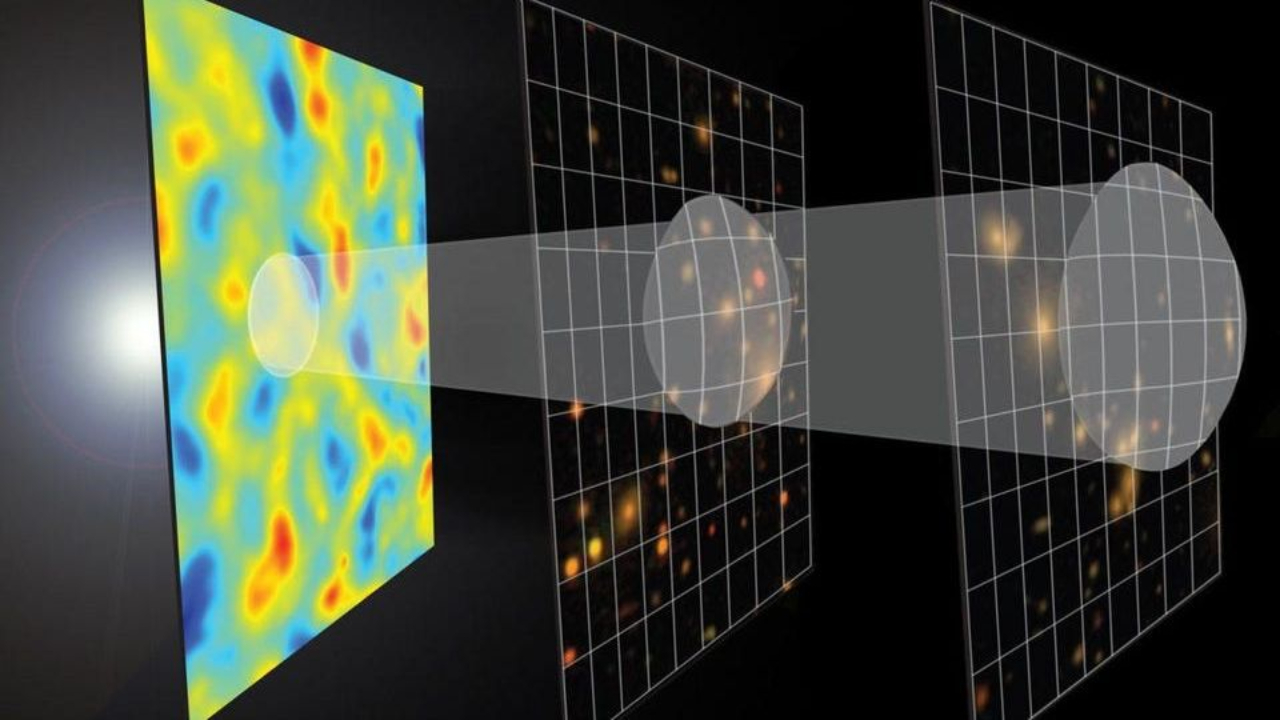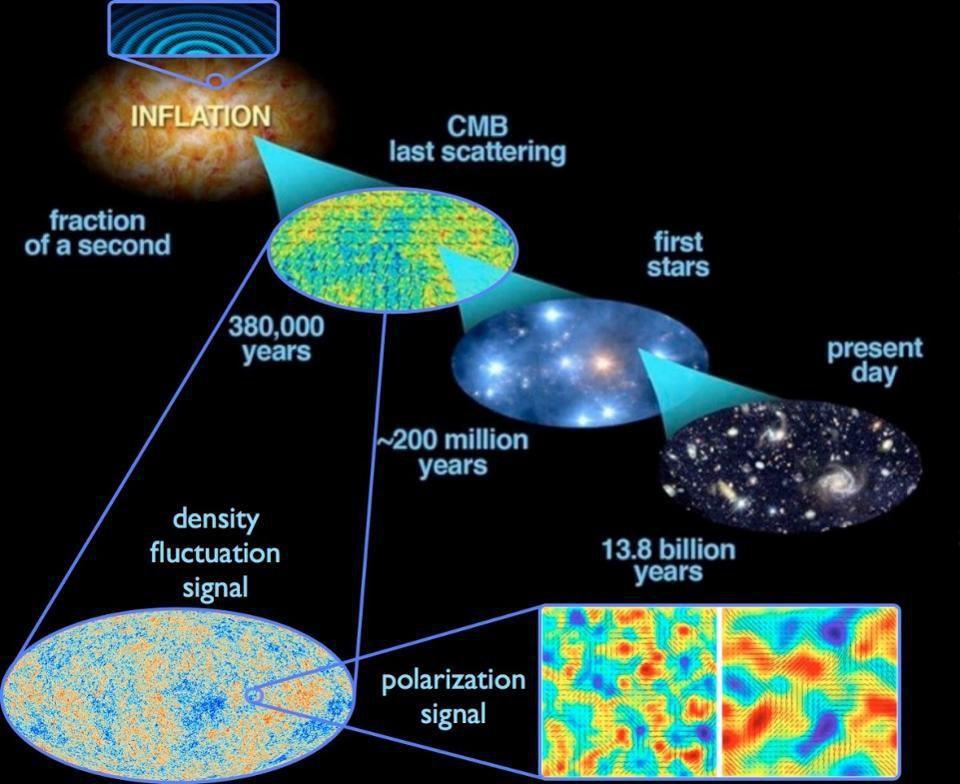Science News
& Faculty Articles
Is JWST Confirming Haramein’s Holographic Solution Predicting that the Universe is a Black Hole?

Recent observations of the JWST challenge the Big Bang origin of our universe, in support of Haramein's Holographic framework where the Universe was created by a black hole embedded in a larger universe. Most of our mainstream astronomy and astrophysics may have to be rewritten!
By Dr. Inés Urdaneta, Physicist at Resonance Science Foundation
In our RSF series concerning the Vacuum Catastrophe problem -the 122 order of magnitude discrepancy between the vacuum energy density at cosmological scale and quantum scale- and the solution provided by the generalized holographic approach [1], we remarked that this solution to the vacuum catastrophe hinted into a very intriguing scenario … that our Universe fulfills the condition of a Black hole once you correctly calculate the contribution of the vacuum fluctuations that dark mass and dark energy account for.
This theoretical prediction might now-a-days be validated with the current observations of the James Webb Space...
Modified Theories of Gravity may be Replacing Dark Matter Sooner Than Expected!

For more than a decade the astrophysical community has been gathering observational evidence that seem to contradict the concept of dark matter in favor of new theories of gravity. In this article we summarize the most important ones, from to 2016 to present.
By Dr. Inés Urdaneta, Physicist at Resonance Science Foundation
As we have explained in former articles, dark matter was inferred as an additional gravitational source that could explain the flattened rotation curves of spiral galaxies; spiral galaxies were found to rotate at a nearly constant rate, independently of its radius. From Newton’s law and the distribution of visible matter, one would expect the rotational velocity of stars and gas inside a galaxy to decrease with distance, but in the 70’s astronomers found this flattened anomaly, and dark matter was born.
Nevertheless, many teams have found astronomical evidence pointing towards modified gravity models instead. For instance, in 2016, a significant...
Axions and the Cosmic Optical Background

Credit: NASA/APL/SwRI and NASA/JPL-Caltech
By Amal Pushp, Affiliate Physicist at the Resonance Science Foundation
The cosmic microwave background (CMB) is the earliest glow of radiation present in the universe that apparently dates back to the time when the universe came into being. Similar to this radiation, there is another glow that is lesser heard of and that corresponds to the light emitted in the visible region of the electromagnetic spectrum, mainly by all astrophysical sources outside the milky way. This radiation encompassing the universe is termed the cosmic optical background (COB). From a technical standpoint, the COB is an ensemble of photons, strictly in the visible spectrum, over the volume of the observable universe. One can infer a significant amount of information about galaxies, stellar clusters, etc from the COB. Furthermore, the phenomena involving mass accretion by black holes associated with the galactic and stellar systems also count within reach...
Are Some of the Black Holes Detected, Wormholes Instead?

Image credit: Shutterstock
By Dr. Inés Urdaneta, Physicist at Resonance Science Foundation
Many compact gravitational objects in the cosmos such as black holes, naked singularities, and wormholes, can only be detected by their shadows’ signatures. Distinguishing their different natures through their shadows is a difficult task because many times their shadows are very similar. Therefore, we can’t rely exclusively on this information to discern unambiguously the specific spacetime geometries from the objects.
For instance, the radio images obtained from the Event Horizon Telescope to directly observe the accretion disks of the supermassive black holes in the galactic centers, are hard to interpret since the information about their gravitational field is coupled non-linearly to the magneto-hydrodynamics of the system.
The main feature analyzed in such images, is their intensity profile. An interesting approach to constrain further the space time geometry, is to...
Cosmic Inflation: Boon or Bane?

Credit: Zosia Rostomian
By Amal Pushp, Affiliate Physicist at the Resonance Science Foundation
Cosmic inflation is a theory governing the dynamics of the early universe, moments after the grand cosmic event called the Big Bang. MIT physicist Alan Guth was the first one to propose the inflationary theory in the early 1980s however, it was later advanced by other influential physicists like Andrei Linde and Paul Steinhardt [1-3]. The theory mainly deals with the exponential expansion of space and subsequently the large-scale structure formation in the universe during its evolutionary stages. It is also suggested by the theory that the epoch of inflation lasted from 10−36 seconds to sometime between 10−33 and 10−32 seconds after the Big Bang. But in order to articulate the events following the Big Bang admirably, one needs to have a full-fledged quantum theory of gravity, which is yet a substantial challenge for physicists.
So far,...
JWST Image of Rings Around Star WR140 Leaves Astrophysicists Baffled!

With its mid-infrared instrument (MIRI), the James Webb Space Telescope captured the star WR140 surrounded by strange concentric shells that gradually fade away.. (Image credit: NASA/ESA /CSA /Ryan Lau /JWST ERS Team /Judy Schmidt)
By Dr. Inés Urdaneta, Physicist at Resonance Science Foundation
An image taken by the James Webb Space Telescope (JWST) in July 2022 showing a star named Wolf-Rayet 140 (WR 140) surrounded by regular ripple-like circles that gradually fade away, was released on Twitter by scientist Judy Schmidt. Star WR140 is in the Cygnus constellation and resides around 5,600 light-years from Earth. The image ignited a torrent of comments, making astronomers and astrophysicists scratch their heads over this unexplained observation.
Wolf-Rayet stars are rare, only 600 have been found, and they’re very short-lived, generating powerful winds that push huge amounts of gas and dust into space, while loosing most of their mass in the process. In this...
Eridanus Supervoid May Explain Cosmic Microwave Background Anomalous Cold Spot

By: William Brown, Biophysicist at the Resonance Science Foundation
A lot of information about the large-scale nature of the universe can be derived from detailed analysis of its ubiquitous thermal electromagnetic field, called the cosmic microwave background (CMB), for instance analysis of suppressed fluctuations at large wavelengths reveals a closed geometry of the universe— a torus-type geometry as we described in the RSF article A New Signature of a Multiply Connected Universe [1].

Inhomogeneities attributed to quantum fluctuations during the inflationary period are amplified across large-scale universal structure, and when inflation ends, they become density fluctuations and cause the differences in temperature observed in the CMB. Its an intriguing signal to study because it reveals an epoch when atomistic and cosmological structure where one-and-the same, and quantum behaviors that typify nature evolves into large-scale structural features of the universe. (Credit...
Extraterrestrial Technosignature Still a Viable Explanation for 'Oumuamua, was it an Interstellar Probe?

By biophysicist William Brown, research scientist at RSF
In 2019 we reported on the first interstellar visitor to our solar system and the interesting proposal by Harvard astronomer Avi Loeb that it could be a possible technosignature of extraterrestrial engineering. Loeb proposed this hypothesis to answer many of the anomalous observables of the interstellar visitor, named 'Oumuamua, such as its oscillating reflectivity— indicating that its profile is changing from a large area to a smaller one, so that it is either flat like a solar sail, or long and thin like a cigar shape and tumbling— the lack of any outgassing as it passed by the Sun, and its anomalous trajectory whereby it accelerated as it left the gravitational well of the Sun and our solar system.
Loeb further expounds that the sudden acceleration and deviation of 'Oumuamua from its expected orbit appeared to be the result of radiation pressure, which is precisely how solar sails achieve propulsion....
The Universe Organizes in a Galactic Neuromorphic Network

Article by William Brown, Biophysicist, Resonance Science Foundation Research Scientist
The Universe Organizes in a Galactic Neuromorphic Network
The Quantitative Comparison Between the Neuronal Network and the Cosmic Web

A key observation in the science of a unified physics of reality is that the universe appears to follow a self-organizational patterning utilizing properties of holography and fractals. These two features of organizational structure in the universe are so ubiquitous that us researchers at the Resonance Science Foundation often refer to “holofractogramic physics” to simultaneously describe an organizational system that is both holographic and fractal in nature. This refers to two properties of universal organization that seem to be primary: holographic ordering of information—in which any subunit of a system contains information about the whole— and fractal ordering of structure.
What does “fractal ordering of...
Prediction of Giant Vortex in Liquid Light!

Article by Dr. Inés Urdaneta, Physicist, Resonance Science Foundation Research Scientist
Photo by Kenji Croman
Just as particles at the very small scale are governed by the strange laws of the quantum world, light can behave weird when placed in the proper conditions. The most intriguing is the case of liquid light that we had addressed in a former article entitled “Liquid light at room temperature”, where light interacts with matter, or more precisely, photons interact with electron-hole pairs – called excitons – in a semiconductor. These excitons impose a dipole moment, which combined with the dipole of the electromagnetic field, couples strongly the excitons and the photons. The result is a polariton, considered a quasiparticle, composed of half-light and half matter which behaves as a Bose Einstein condensate or superfluid even at room temperature. A superfluid behaves like a fluid with zero viscosity. Zero viscosity is equivalent to perpetual...



